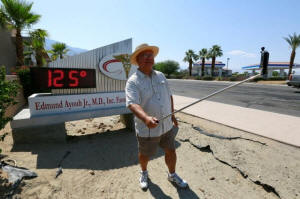|
Heat wave tests Southern California's
power grid amid gas shortage
 Send a link to a friend
Send a link to a friend
 [June 21, 2016]
By Steve Gorman and Nichola Groom [June 21, 2016]
By Steve Gorman and Nichola Groom
LOS ANGELES (Reuters) - California's power
grid operators warned homes and businesses on Monday to conserve
electricity as rising demand for air conditioning stoked by a
record-setting heat wave across the U.S. Southwest tested the region's
generating capacity.
The so-called Flex Alert was posted until 9 p.m. Pacific time
during a second day of triple-digit temperatures that strained
Southern California's energy production, creating a potential for
rolling blackouts on the first official day of summer.
But the peak hour for energy demand came and went Monday evening
without disruption of the region's power delivery network, the
California Independent System Operator (ISO) reported.
"Since we're past that and have not experienced any trouble, I think
we're headed into the safe zone," agency spokeswoman Anne Gonzales
told Reuters.
Temperatures were expected to begin abating on Tuesday, according to
weather forecasts. As of Monday night, there were no plans to extend
the Flex Alert, ISO officials said.
Monday's alert was the first big test of power generators' ability
to meet heightened energy demands in the greater Los Angeles area
without natural gas supplies normally furnished by the now-crippled
Aliso Canyon gas storage field, effectively idled since a major well
rupture there last fall.
 The oven-like heat prompted the city of Los Angeles to keep its
network of public "cooling centers" - libraries, recreation centers
and senior centers - open for extended hours as a haven for people
whose homes lack air conditioning.
Area home improvement and hardware merchants were doing a brisk
business in fans and AC window units.
Brett Lopes, 31, a freelance lighting technician, stopped in a Home
Depot outlet near downtown to buy supplies for a homemade air
conditioner he called a "swamp cooler" to use while he waited for
his landlord to repair his broken AC unit.
"It's brutal," he said of the heat, explaining that he looked up
directions on YouTube for assembling the makeshift cooling device.
"It doesn't work as well as AC, but it's better than sitting in 100
degrees."
Others flocked to public swimming pools.
"It was really refreshing today, but more crowded than usual," said
Paul Stephens, 31, a pastor who was swimming laps at the Rose Bowl
Aquatic Center in Pasadena, where the mercury climbed to 108
Fahrenheit (42 Celsius) .
BALANCING THE GRID
The ISO, which runs the state's power grid, urged consumers on
Monday to cut back on electricity usage, especially during
late-afternoon hours.
Utility customers were advised to turn off unnecessary lights, set
air conditioners to 78 degrees Fahrenheit or higher, and wait until
after 9 p.m. to run major appliances, such as clothes washers and
dryers.
[to top of second column] |

Palm Springs resident Benito Almojuela takes a selfie near a
thermometer sign which reads 125 degrees in Palm Springs,
California, June 20, 2016. REUTERS/Sam Mircovich

Gonzales credited public cooperation with the flex alert for likely
helping avert widespread outages on Monday.
Large stretches of three states sweltered in a second straight day
of record, triple-digit temperatures, as the National Weather
Service posted excessive-heat warnings through Wednesday for
southern portions of California, Arizona and Nevada, though the hot
spell appeared to have peaked on Monday.
Power customers ranging from homes and hospitals to oil refineries
and airports are at risk of losing energy at some point this summer
because a majority of electric-generating stations in California use
gas as their primary fuel.
Since the energy crisis of 2000-2001, the ISO has imposed brief,
rotating outages in 2004, 2005, 2010 and 2015, mostly related to
unexpected transmission line or power plant failures during periods
of unusually high demand.
With California's largest natural gas storage field shut down
indefinitely at Aliso Canyon, state regulators have warned that Los
Angeles faces up to 14 days of gas shortages severe enough to
trigger blackouts this summer.
Aliso Canyon, owned by Southern California Gas Co, a division of San
Diego-based utility giant Sempra Energy, normally supplies the
region's 17 gas-fired power plants, hospitals, refineries and other
key parts of California's economy, including 21 million residents.
The gas leak there, ranking as the worst-ever accidental methane
release in the United States, forced thousands of nearby residents
from their homes for several months after it was detected last
October. The leak was finally plugged in February.
(Reporting by Scott DiSavino in New York; Writing and additional
reporting by Steve Gorman in Los Angeles; Editing by Leslie Adler
and Andrew Hay)
[© 2016 Thomson Reuters. All rights
reserved.]
Copyright 2016 Reuters. All rights reserved. This material may not be published,
broadcast, rewritten or redistributed.
 |